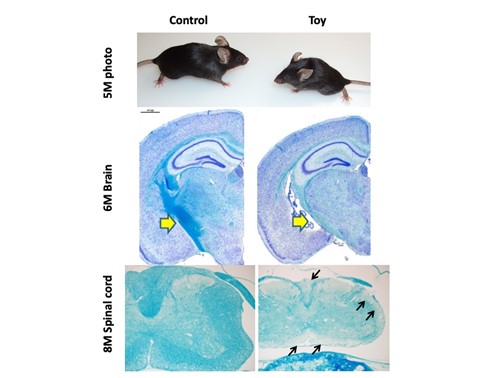 |
October 2021 Mouse of the Month |
|
A novel vanishing white matter disease model; toy mice
B6.Cg-Eif2b5<toy> (RBRC10057)
|
| Vanishing white matter disease (VWM; OMIM # 603896) is an autosomal recessive neurological disorder characterized by variable neurologic features (progressive cerebellar ataxia, spastic palsy, epilepsy, cognitive impairment, etc.) associated with white matter lesions on brain MRI imaging. VWM clinical feature is rapid and major neurological deterioration provoked by stresses, such as viral fever and head injury. VWM is caused by mutation of any genes encoding eukaryotic translation initiation factor 2B (eIF2B) subunits(α,β,γ,δ,ε). eIF2B is an activator of translation initiation factor eIF2, which controls translation initiation in eucaryotic cells. However, under endoplasmic reticulum (ER) stress conditions, activation of both eIF2B and eIF2 is inhibited, which causes global decrease of protein synthesis. Not only the detailed molecular mechanism of this stress response but also the relationship with VWM pathogenesis is still unknown. A novel VWM model strain named toy (RBRC10057 and RBRC10058) is a spontaneous mutated strain, which is isolated for characteristic phenotypes such as a small body and abnormal gait from mouse colony maintained by Dr. Terumitsu. Toy mice show some abnormal features commonly observed in VWM patients as follows: physical phenotypes (a small body, abnormal gait, male and female infertility, and epileptic seizures), biochemical and histological data (increased expression of ER stress response factors), pathological data (distribution of myelin and abnormal clustering of oligodendrocytes in the white matter), etc. Depositor (Dr. Terumitsu) and her colleagues already revealed that toy mice harbor a point mutation in Eif2b5 gene coding for eIF2Bε subunit (C>G, Ile98Met) and this missense mutation results in constitutive reduction of both eIF2B and eIF2 activity. In addition, it was reported that the genetic background (C57BL/6 (RBRC10057) and C3H (RBRC10058)) affects severity of VWM-like phenotypes in toy mice. In brief, these VWM model mice are useful for elucidation of pathogenic mechanisms and development of new therapeutic drugs or methods. |
| Depositor | : | Mika Terumitsu-Tsujita, Ph.D. Niigata University (at the time of the strain deposition) |
|
| Strain name | : | B6.Cg-Eif2b5<toy> | |
| RBRC No. | : | RBRC10057 (C57BL/6 background) | |
| Strain name | : | C3H.Cg-Eif2b5<toy> | |
| RBRC No. | : | RBRC10058 (C3H background) | |
| Reference | : | [1] | Terumitsu-Tsujita M, Kitaura H, Miura I, Kiyama Y, Goto F, Muraki Y, Ominato S, Hara N, Simankova A, Bizen N, Kashiwagi K, Ito T, Toyoshima Y, Kakita A, Manabe T, Wakana S, Takebayashi H, Igarashi H. Glial pathology in a novel spontaneous mutant mouse of the Eif2b5 gene: a vanishing white matter disease model. J Neurochem. 2020 Jul;154(1):25-40. |
| October 2021 Saori Mizuno, Ph.D. Contact: Experimental Animal Division, RIKEN BioResource Research Center (animal.brc@riken.jp) All materials contained on this site may not be reproduced, distributed, displayed, published or broadcast without the prior permission of the owner of that content. |





